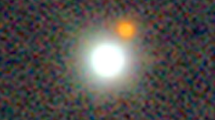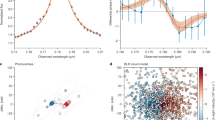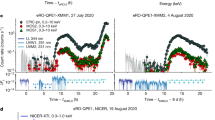Abstract
The co-evolution of a supermassive black hole with its host galaxy1 through cosmic time is encoded in its spin2,3,4. At z > 2, supermassive black holes are thought to grow mostly by merger-driven accretion leading to high spin. It is not known, however, whether below z ≈ 1 these black holes continue to grow by coherent accretion or in a chaotic manner5, though clear differences are predicted3,4 in their spin evolution. An established method6 of measuring the spin of black holes is through the study of relativistic reflection features7 from the inner accretion disk. Owing to their greater distances from Earth, there has hitherto been no significant detection of relativistic reflection features in a moderate-redshift quasar. Here we report an analysis of archival X-ray data together with a deep observation of a gravitationally lensed quasar at z = 0.658. The emission originates within three or fewer gravitational radii from the black hole, implying a spin parameter (a measure of how fast the black hole is rotating) of a =  at the 3σ confidence level and a > 0.66 at the 5σ level. The high spin found here is indicative of growth by coherent accretion for this black hole, and suggests that black-hole growth at 0.5 ≤ z ≤ 1 occurs principally by coherent rather than chaotic accretion episodes.
at the 3σ confidence level and a > 0.66 at the 5σ level. The high spin found here is indicative of growth by coherent accretion for this black hole, and suggests that black-hole growth at 0.5 ≤ z ≤ 1 occurs principally by coherent rather than chaotic accretion episodes.
This is a preview of subscription content, access via your institution
Access options
Subscribe to this journal
Receive 51 print issues and online access
$199.00 per year
only $3.90 per issue
Buy this article
- Purchase on Springer Link
- Instant access to full article PDF
Prices may be subject to local taxes which are calculated during checkout



Similar content being viewed by others
References
Gebhardt, K. et al. A relationship between nuclear black hole mass and galaxy velocity dispersion. Astrophys. J. 539, L13–L16 (2000)
Berti, E. & Volonteri, M. Cosmological black hole spin evolution by mergers and accretion. Astrophys. J. 684, 822–828 (2008)
Fanidakis, N. et al. Grand unification of AGN activity in the ΛCDM cosmology. Mon. Not. R. Astron. Soc. 410, 53–74 (2011)
Volonteri, M., Sikora, M., Lasota, J.-P. & Merloni, A. The evolution of active galactic nuclei and their spins. Astrophys. J. 775, 94 (2013)
King, A. R. & Pringle, J. E. Growing supermassive black holes by chaotic accretion. Mon. Not. R. Astron. Soc. 373, L90–L92 (2006)
Risaliti, G. et al. A rapidly spinning supermassive black hole at the centre of NGC1365. Nature 494, 449–451 (2013)
Ross, R. R. & Fabian, A. C. The effects of photoionization on X-ray reflection spectra in active galactic nuclei. Mon. Not. R. Astron. Soc. 261, 74–82 (1993)
Tanaka, Y. et al. Gravitationally redshifted emission implying an accretion disk and massive black hole in the active galaxy MCG-6-30-15. Nature 375, 659–661 (1995)
Crummy, J., Fabian, A. C., Gallo, L. & Ross, R. R. An explanation for the soft X-ray excess in active galactic nuclei. Mon. Not. R. Astron. Soc. 365, 1067–1081 (2006)
Walton, D. J., Nardini, E., Fabian, A. C., Gallo, L. C. & Reis, R. C. Suzaku observations of ‘bare’ active galactic nuclei. Mon. Not. R. Astron. Soc. 428, 2901–2920 (2013)
Porquet, D., Reeves, J. N., O'Brien, P. & Brinkmann, W. XMM-Newton EPIC observations of 21 low-redshift PG quasars. Astron. Astrophys. 422, 85–95 (2004)
Piconcelli, E. et al. The XMM-Newton view of PG quasars. I. X-ray continuum and absorption. Astron. Astrophys. 432, 15–30 (2005)
Jiménez-Bailón, E. et al. The XMM-Newton view of PG quasars. II. Properties of the Fe K_α line. Astron. Astrophys. 435, 449–457 (2005)
Green, P. J. et al. A full year’s Chandra exposure on Sloan Digital Sky Survey quasars from the Chandra Multiwavelength Project. Astrophys. J. 690, 644–669 (2009)
Pooley, D., Blackburne, J. A., Rappaport, S. & Schechter, P. L. X-ray and optical flux ratio anomalies in quadruply lensed quasars. I. Zooming in on quasar emission regions. Astrophys. J. 661, 19–29 (2007)
Chartas, G. et al. Revealing the structure of an accretion disk through energy-dependent X-ray microlensing. Astrophys. J. 757, 137 (2012)
Gilli, R., Comastri, A. & Hasinger, G. The synthesis of the cosmic X-ray background in the Chandra and XMM-Newton era. Astron. Astrophys. 463, 79–96 (2007)
Sluse, D., Hutsemékers, D., Courbin, F., Meylan, G. & Wambsganss, J. Microlensing of the broad line region in 17 lensed quasars. Astron. Astrophys. 544, A62 (2012)
Sluse, D. et al. A quadruply imaged quasar with an optical Einstein ring candidate: 1RXS J113155.4–123155. Astron. Astrophys. 406, L43–L46 (2003)
Dai, X. et al. The sizes of the X-ray and optical emission regions of RXJ 1131–1231. Astrophys. J. 709, 278–285 (2010)
Reis, R. C. & Miller, J. M. On the size and location of the X-ray emitting coronae around black holes. Astrophys. J. Lett. 769, 7 (2013)
Reynolds, C. S. Measuring black hole spin using x-ray reflection spectroscopy. Space Sci. Rev http://dx.doi.org/10.1007/s11214-013-0006-6 (published online 31 August 2013)
Fabian, A. C. et al. Broad line emission from iron K- and L-shell transitions in the active galaxy 1H0707–495. Nature 459, 540–542 (2009)
Miller, J. M. Relativistic X-ray lines from the inner accretion disks around black holes. Annu. Rev. Astron. Astrophys. 45, 441–479 (2007)
Schmoll, S. et al. Constraining the spin of the black hole in Fairall 9 with Suzaku. Astrophys. J. 703, 2171–2176 (2009)
Haardt, F. & Maraschi, L. A two-phase model for the X-ray emission from Seyfert galaxies. Astrophys. J. 380, L51–L54 (1991)
Falcke, H. & Markoff, S. The jet model for Sgr A*: radio and X-ray spectrum. Astron. Astrophys. 362, 113–118 (2000)
Walton, D. J., Reis, R. C., Cackett, E. M., Fabian, A. C. & Miller, J. M. The similarity of broad iron lines in X-ray binaries and active galactic nuclei. Mon. Not. R. Astron. Soc. 422, 2510–2531 (2012)
Reynolds, C. S. & Fabian, A. C. Broad iron-Kα emission lines as a diagnostic of black hole spin. Astrophys. J. 675, 1048–1056 (2008)
Miller, J. M. et al. On relativistic disk spectroscopy in compact objects with X-ray CCD cameras. Astrophys. J. 724 1441–1455 (2010) http://dx.doi.org/10.1088/0004-637X/724/2/1441
Chartas, G., Kochanek, C. S., Dai, X., Poindexter, S. & Garmire, G. X-ray microlensing in RXJ1131-1231 and HE1104-1805. Astrophys. J. 693, 174–185 (2009)
Fruscione, A. et al. CIAO: Chandra’s data analysis system. SPIE Conf. Ser. 6270, http://adsabs.harvard.edu/abs/2006SPIE.6270E..60F (2006)
Tsunemi, H. et al. Improvement of the spatial resolution of the ACIS using split-pixel events. Astrophys. J. 554, 496–504 (2001)
Wang, J. et al. A deep Chandra ACIS study of NGC 4151. I. The X-ray morphology of the 3 kpc diameter circum-nuclear region and relation to the cold interstellar medium. Astrophys. J. 729, 75 (2011)
Davis, J. E. Event pileup in charge-coupled devices. Astrophys. J. 562, 575–582 (2001)
Russell, H. R. et al. The X-ray luminous cluster underlying the bright radio-quiet quasar H1821+643. Mon. Not. R. Astron. Soc. 402, 1561–1579 (2010)
Dauser, T., Wilms, J., Reynolds, C. S. & Brenneman, L. W. Broad emission lines for a negatively spinning black hole. Mon. Not. R. Astron. Soc. 409, 1534–1540 (2010)
Dickey, J. M. & Lockman, F. J. H. I in the Galaxy. Annu. Rev. Astron. Astrophys. 28, 215–259 (1990)
Balucinska-Church, M. & McCammon, D. Photoelectric absorption cross sections with variable abundances. Astrophys. J. 400, 699–700 (1992)
Anders, E. & Grevesse, N. Abundances of the elements—meteoritic and solar. Geochim. Cosmochim. Acta 53, 197–214 (1989)
Tewes, M. et al. COSMOGRAIL: the COSmological MOnitoring of GRAvItational Lenses. XIII. Time delays and 9-yr optical monitoring of the lensed quasar RX J1131-1231. Astron. Astrophys. 556, A22 (2013)
Acknowledgements
R.C.R. thanks the Michigan Society of Fellows and NASA for support through the Einstein Fellowship Program, grant number PF1-120087. We thank the ESA XMM-Newton Project Scientist N. Schartel and the XMM-Newton planning team for carrying out the DDT observation. The scientific results reported in this article are based on data obtained from the Chandra Data Archive.
Author information
Authors and Affiliations
Contributions
R.C.R. performed the data reduction and analysis of all the Chandra data reported here. The XMM-Newton data was reduced by both R.C.R and M.T.R. The pile-up study was carried out by R.C.R., J.M.M. and M.T.R. The text was composed, and the paper synthesised, by R.C.R., with help from D.J.W. and M.T.R. The smoothed subpixel images were made by R.C.R. and M.T.R. All authors discussed the results and commented on the manuscript.
Corresponding author
Ethics declarations
Competing interests
The authors declare no competing financial interests.
Extended data figures and tables
Extended Data Figure 1 Phenomenological models for all 27 Chandra observations of image B.
a, Chandra data has been fitted with a DISKBB component to mimic the soft excess as well as a RELLINE line profile to account for the residuals in the 2–4-keV range and a power law for the continuum. The normalization of the various components, as well as the power-law indices, is allowed to vary between epochs. However, the intrinsic column density, the ionization state (related to the centroid of the line), the emissivity profile and the inclination of the disk are assumed to be unchanging between the various epochs. b, Data-to-model ratio plot, made in a manner similar to that for Extended Data Fig. 2, for all 27 epochs. The solid magenta line is the baseline theoretical best-fitting model-to-power-law ratio expected from the self-consistent REFLIONX model found for epoch 23. The data have been rebinned for visual clarity.
Extended Data Figure 2 Co-added Chandra spectra of the various Chandra images during all observations.
a, The spectra for images B (black) and C (magenta) are shown fitted with a simple power law, and the residuals to this model are shown in units of 1σ deviations in the middle panel. The data in the bottom panel have been rebinned for display purposes. b, Co-added spectra of periods 1 and 3 (black) and period 2 (magenta) of image D shown as residuals to a simple power law together with Gaussians similar to those shown in ref. 16. The residuals to this model are shown in units of 1σ deviations. The bottom panel shows similar residuals for the corresponding periods 1+3 of image A. The data have been rebinned for display purposes.
Extended Data Figure 3 Co-added spectrum of all Chandra epochs fitted with the baseline-reflection model.
a, The spectrum was fitted with a physically motivated, self consistent model for both the soft excess and the broad Fe line. The residuals to the model are shown in the middle panel. The REFLIONX, power-law and narrow Gaussian components are shown in magenta, green and blue, respectively, with the total model shown in cyan. The blue vertical line is the narrow Gaussian component. The bottom panel shows the residuals without the narrow Gaussian component. b, Extrapolated model showing a reflection-dominated continuum. The data were rebinned for display purposes.
Extended Data Figure 4 Co-added spectra of all Chandra images fitted with the baseline-simple model.
a, The unfolded spectrum is shown for the best-fitting simple model with the relativistic line, soft disk component and power law shown in magenta, blue and green, respectively. The residuals to this model are shown in units of 1σ deviations in the middle panel. The bottom panel shows the residuals after rebinning the data for display purposes. b, The top panel shows the residuals to a simple power law and the bottom panel shows similar residuals after the addition of a DISKBB component.
Extended Data Figure 5 Goodness of fit versus spin parameter.
a, Range of spin values found by fitting image B alone. b, Similar value for the spin, albeit at a lesser statistical significance, is found when using image C alone. By co-adding the spectra we are probing the time-averaged behaviour of the reflection spectrum. Fits were made with the spin parameter varying from 0.495 to 0.995 in steps of 0.01. The blue contour was made using the relativistic line model RELLINE assuming a broken emissivity profile and a further narrow Gaussian line at 6.4 keV. The black contour assumes a broken emissivity without the extra narrow Gaussian line. The magenta contour is for the self-consistent REFLIONX model together with the RELCONV blurring kernel and a Gaussian line at 6.4 keV (see text for details). For image B, we have also included the green contour, found for the time-resolved analyses described in section 3.2.1 of the Supplementary Information. c, Co-added spectrum of all Chandra (magenta contour), XMM-Newton (green contour) and simultaneous data (black contour). These contours are made with the baseline-reflection model. The dotted lines show the 99.99%, 99.73% (3σ) and 90% confidence limits.
Extended Data Figure 6 XMM-Newton EPIC-PN spectrum of RX J1131−1231.
a, The unfolded spectrum is shown with a broken power law, together with a soft excess and narrow Gaussian in magenta. The second panel from the top shows the residuals upon removal of the soft component, the narrow line and the break in the power law. The next panel down shows the fit with the addition of a break in the power law and the bottom panel shows the best phenomenological fit to the XMM-Newton data. b, XMM-Newton data, now fitted with the baseline-reflection model. The reflection component is again shown in magenta, with the total, power-law and narrow lines shown in black, green and blue, respectively. The bottom panel shows the ratio to this model. The data have been rebinned for display purposes.
Extended Data Figure 7 Detected counts per frame as a function of observation epoch.
The counts have been corrected with a PSF to account for the size of the extraction region. As such, the counts presented are approximately a factor of 1.69, 1.71, 1.69 and 1.21 higher that that observed for images A, B, C and D, respectively. We show with solid and dotted horizontal lines the expected 10% pile-up fraction assuming grade migration parameters of α = 1 and 0.5, respectively. The highlighted epoch corresponds to that used in the in-depth study of possible spectral distortions caused by pile-up/cross-contamination. We use this epoch to assess the implication of high count rate on our results as it presents the greatest chance of cross-contamination due to the peak brightness of image A. The work highlighted in the Methods shows that the features observed in this epoch are consistent with those observed in all (fainter) observations.
Extended Data Figure 8 Testing for pile-up in a bright Chandra observation.
a, Chandra spectra of images B, C and D from the observation made on 28 November 2009. This observation is highlighted in Extended Data Fig. 1 and is representative of the brightest Chandra epochs used in this work. It is also the observation in which image A is at its brightest and therefore presents the largest chance of cross-contamination because sources are only about 1′′ apart. The spectra were fitted phenomenologically with a combination of power-law, DISKBB and RELLINE line profiles to describe the continuum, soft excess and Fe emission features, respectively. The ratios to the model are shown both with (centre) and without (bottom) the disk component representing the soft excess. The spectra of images B, C and D are shown in black, magenta and green, respectively. The power-law, DISKBB and RELLINE components for image B are shown in cyan, magenta and blue, respectively, with the total model shown as solid lines for the three images. b, Data-to-model ratio obtained after removing the RELLINE and DISKBB components (top) and after refitting with a single power law (bottom). The ratio for images B, C and D are shown in black, magenta and green, respectively, and have been rebinned for display purposes. Despite the different flux levels of these three images, it is clear that the residuals to a simple power law remains similar, suggesting that pile-up is not significant in the brightest observations of image B.
Supplementary information
Supplementary Information
This file contains Supplementary Text and additional references. (PDF 238 kb)
Rights and permissions
About this article
Cite this article
Reis, R., Reynolds, M., Miller, J. et al. Reflection from the strong gravity regime in a lensed quasar at redshift z = 0.658. Nature 507, 207–209 (2014). https://doi.org/10.1038/nature13031
Received:
Accepted:
Published:
Issue Date:
DOI: https://doi.org/10.1038/nature13031
This article is cited by
-
X-ray astronomy comes of age
Nature (2022)
-
Towards Precision Measurements of Accreting Black Holes Using X-Ray Reflection Spectroscopy
Space Science Reviews (2021)
-
Observational signatures from horizonless black shells imitating rotating black holes
Journal of High Energy Physics (2018)
-
Difficulties of quantitative tests of the Kerr-hypothesis with X-ray observations of mass accreting black holes
General Relativity and Gravitation (2018)
-
Cosmic lens reveals spinning black hole
Nature (2014)
Comments
By submitting a comment you agree to abide by our Terms and Community Guidelines. If you find something abusive or that does not comply with our terms or guidelines please flag it as inappropriate.



